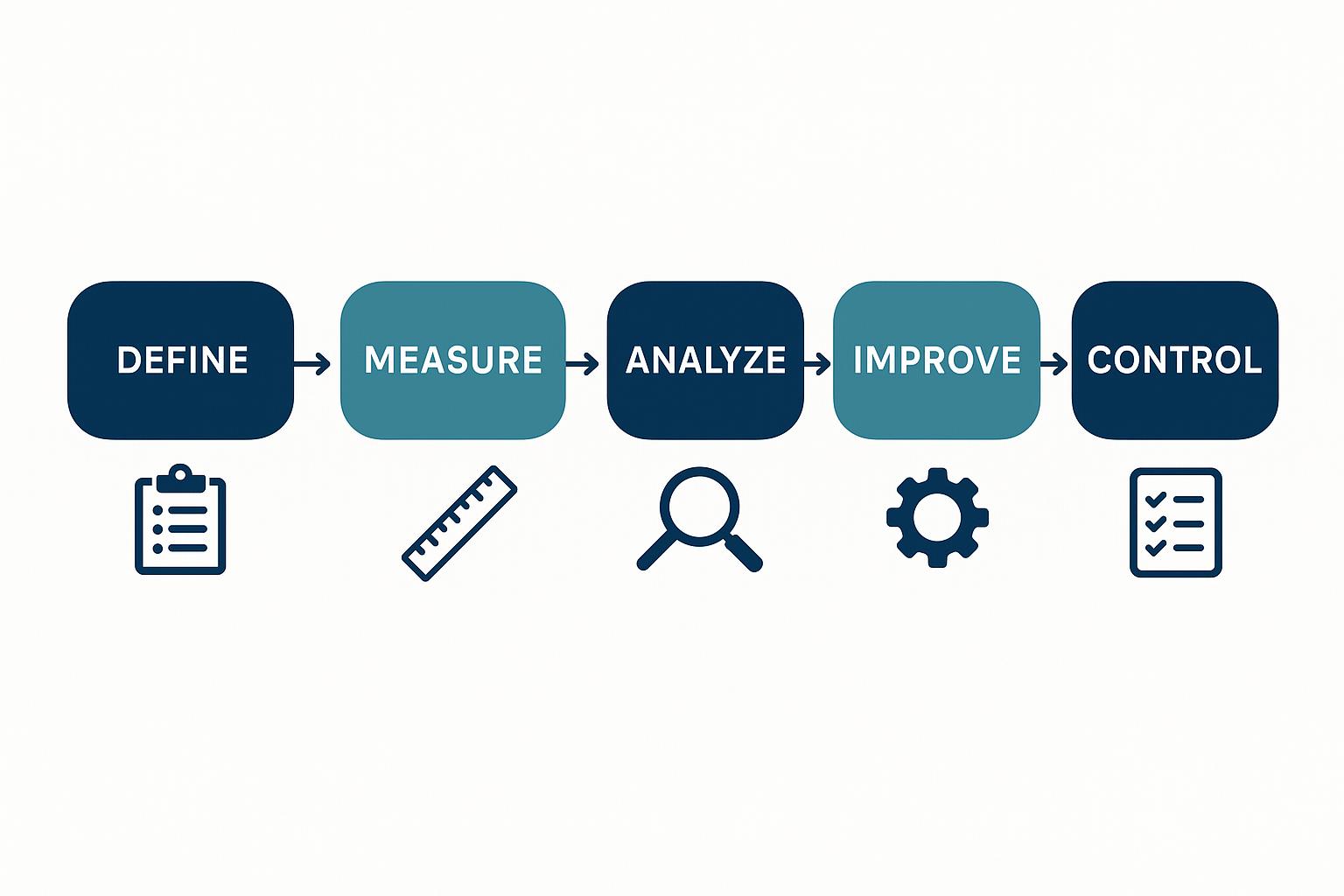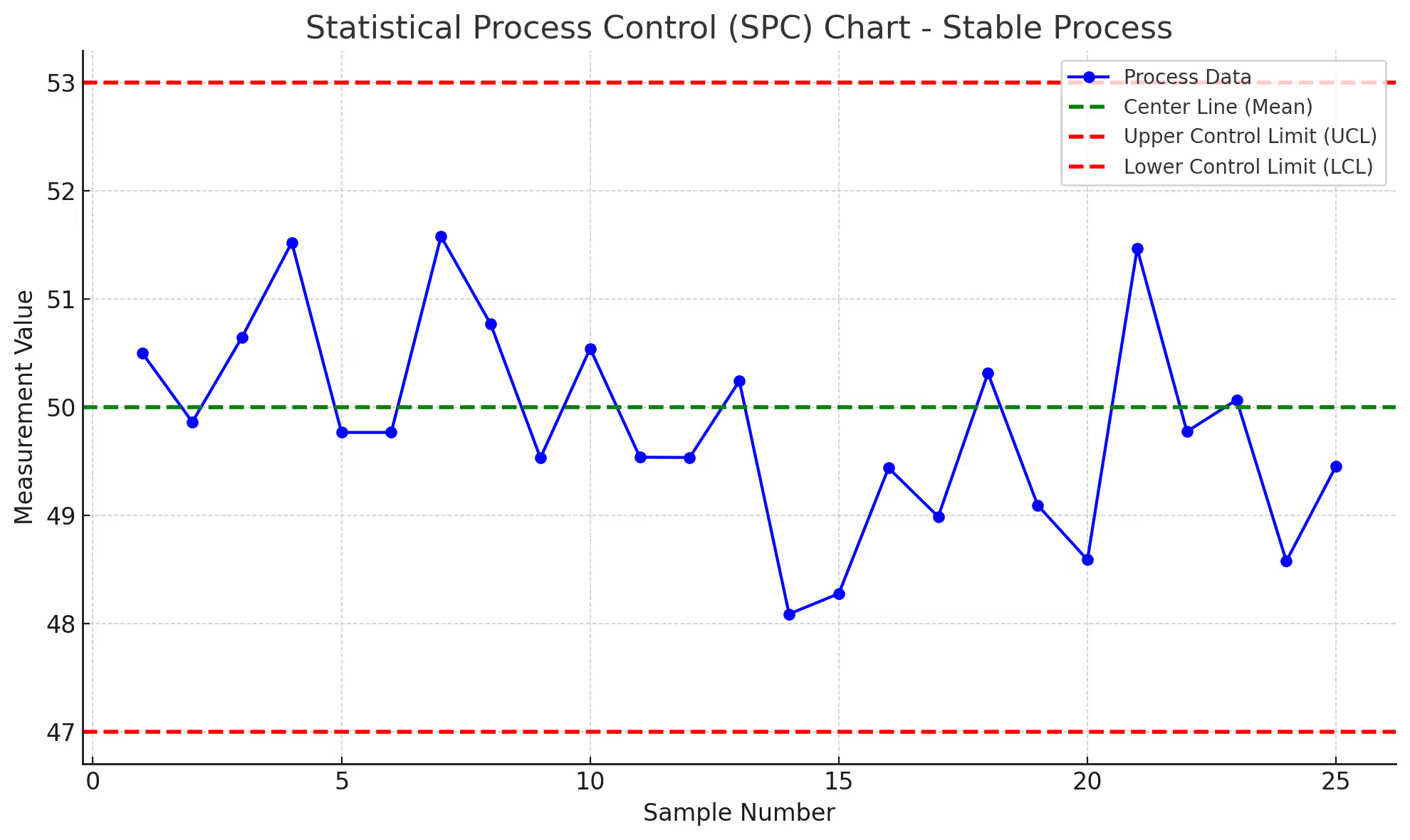After 35 years implementing Lean Six Sigma across oil platforms, hospital systems, and semiconductor plants, the most common question remains: "What exactly is Lean Six Sigma?"
The textbook answer talks about reducing waste and variation. The consultant's answer mentions DMAIC and statistical tools. But the field reality? Lean Six Sigma is a systematic way to see problems that others miss and fix them with methods that actually stick.
Here's what three decades across three industries revealed about what Lean Six Sigma really is—and why it works when other approaches fail.
The Two-Part Power: Understanding Lean and Six Sigma
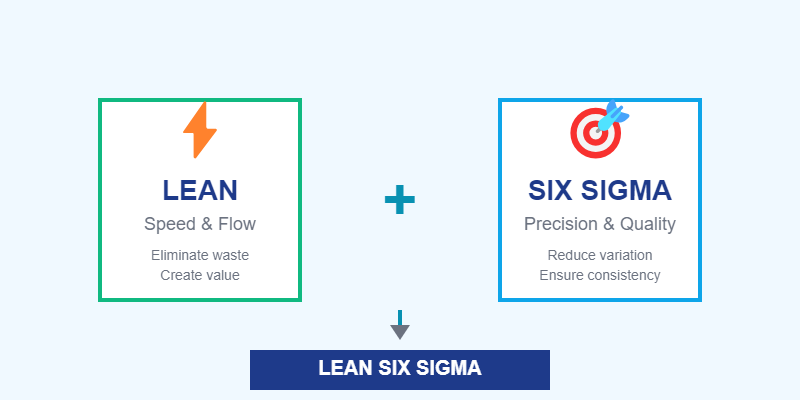
Lean Six Sigma combines two proven methodologies that were once separate. Understanding each part reveals why together they're unstoppable.
Lean: The Speed Side
Lean came from Toyota's production floors, documented extensively in Taiichi Ohno's "Toyota Production System" and later popularized by Womack and Jones in "Lean Thinking." The focus: eliminating waste and creating flow. In practice, Lean asks: "Why does this take so long?"
An oil refinery implementation reduced turnaround time from 45 to 28 days by mapping every step and eliminating the waiting between them. No complex statistics—just systematic observation and common sense applied rigorously.
In hospitals, the same Lean principles cut emergency room wait times by more than a third. The waste was different (patient handoffs instead of equipment changeovers), but the pattern was identical: time lost between value-adding steps.
Six Sigma: The Precision Side
Six Sigma emerged from Motorola in the 1980s, with Bill Smith and Mikel Harry developing the methodology to reduce defects through statistical control. Six Sigma asks: "Why do results vary so much?"
A semiconductor manufacturing facility reduced defect rates from several percent to near-zero using Six Sigma methods to understand the statistical patterns behind failures. Every adjustment was based on data, not opinions.
The same statistical approach in an 11-hospital system reduced medication errors by two-thirds. Different industry, same principle: variation kills quality.
The Combination That Changed Everything
When General Electric adopted Six Sigma under Jack Welch in 1995, combining it with Lean principles, something powerful emerged. GE's annual reports from 1996-2001 document billions in savings from this combined approach. Lean's speed plus Six Sigma's precision created a methodology that could tackle any operational problem.
Michael L. George's seminal work "Lean Six Sigma: Combining Six Sigma Quality with Lean Production Speed" explains why this combination works: Lean accelerates processes while Six Sigma ensures they're done right. Field experience across hundreds of implementations confirms this consistently—speed without precision creates chaos, precision without speed frustrates everyone.
How Lean Six Sigma Really Works: The DMAIC Framework
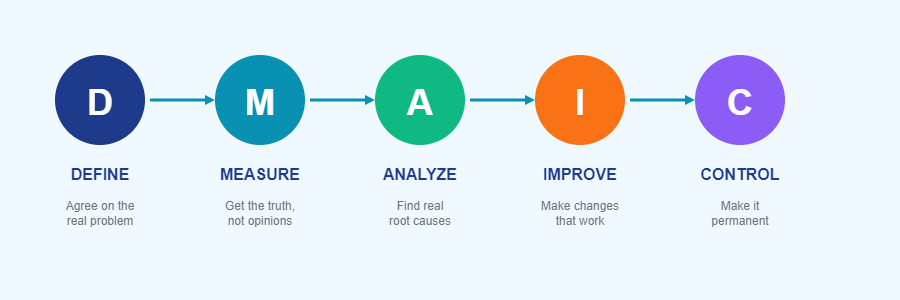
Forget the acronym for a moment. DMAIC (Define, Measure, Analyze, Improve, Control) is simply how logical problem-solving happens, now with structure and tools.
Define: Agreeing on the Real Problem
Most initiatives fail here. Teams think they're solving different problems.
On a drilling platform, everyone agreed "safety was the problem." But the Define phase revealed five different definitions of safety across five departments. No wonder previous efforts failed—they were solving different problems.
Measure: Getting the Truth, Not Opinions
"We're pretty efficient" becomes "we're at 62% efficiency" when measured. Reality often surprises.
A manufacturing plant manager insisted their best line ran at exceptional efficiency. Actual measurement showed it was significantly lower. Not because anyone lied, but because nobody had actually measured.
Analyze: Finding Real Root Causes
This is where Six Sigma's statistical tools shine and Lean's waste identification excels. Together, they reveal what's really happening.
Statistical analysis at a refinery revealed that the vast majority of safety incidents happened during shift changes—invisible without data. Lean analysis showed why: no standard handoff procedure existed.
Improve: Making Changes That Work
Here's where field experience diverges from textbooks. Perfect solutions that people won't follow are worthless. Good solutions that people embrace transform organizations.
A semiconductor fab needed to reduce contamination. The "perfect" solution required operators to follow complex multi-step procedures. It failed immediately. The practical solution—visual markers and simple checks—achieved dramatic contamination reduction because people actually did it.
Control: Making Improvements Permanent
Most improvements die here. The excitement fades, old habits return, and gains evaporate.
Control phase creates systems that make backsliding harder than maintaining improvements. Research on organizational change consistently shows that improvements with formal control systems are far more likely to sustain.
The Universal Patterns: What Works Everywhere
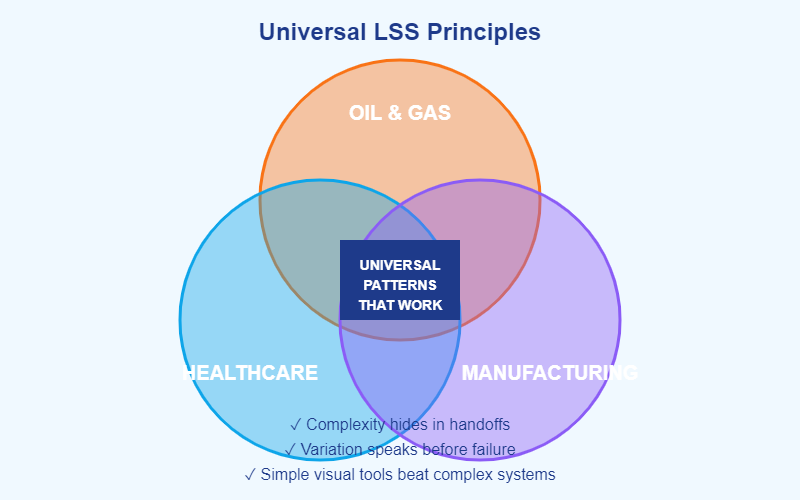
After applying Lean Six Sigma across industries, universal patterns emerge that textbooks miss:
Pattern 1: Complexity Hides in Handoffs
Whether it's shift changes on oil platforms, patient transfers in hospitals, or lot transitions in manufacturing, the spaces between processes cause more problems than the processes themselves.
Pattern 2: Variation Speaks Before Failure
Equipment doesn't suddenly fail. Patients don't suddenly crash. Quality doesn't suddenly deteriorate. Variation increases first—if you're measuring it.
Pattern 3: Simple Visual Tools Beat Complex Systems
The most sophisticated statistical analysis means nothing if frontline workers can't use it. Simple visual management—color codes, charts, markers—drives more improvement than complex dashboards.
Common Misconceptions: What Lean Six Sigma Isn't
It's Not Just Manufacturing
While Lean Six Sigma started in manufacturing—documented in Motorola's quality journey and Toyota's production system—that's like saying electricity is just for light bulbs. The principles apply wherever processes exist.
It's Not About Perfection
"Six Sigma" technically means 3.4 defects per million opportunities. In reality? It's about being better than yesterday, consistently.
It's Not Just Tools and Statistics
Owning a hammer doesn't make someone a carpenter. Knowing statistical formulas doesn't create improvement. Success comes from knowing which tool when, adapting to context, and—most critically—getting people to change behavior.
Real ROI: What Results Actually Look Like
Oil & Gas: Safety and Reliability
A major operator reduced safety incidents by nearly three-quarters over three years using Lean Six Sigma. The financial savings were significant, but the real value? Workers going home safely.
Healthcare: Quality and Experience
A multi-hospital system improved their CMS star ratings from below average to well above using Lean Six Sigma methods. Beyond the financial incentives, this meant thousands of patients receiving better care.
Manufacturing: Yield and Efficiency
A semiconductor manufacturer increased yield from low 90s to high 90s using Six Sigma's statistical methods. In high-margin products, that seemingly small percentage improvement translated to tens of millions annually.
The Evolution: From Traditional to Predictive
Lean Six Sigma has served well for three decades, but the methodology continues evolving. Current research in operational excellence points toward predictive and prescriptive analytics—catching problems before they occur, not just fixing them efficiently.
Advanced practitioners combine traditional Lean Six Sigma with:
Predictive analytics that forecast problems weeks in advance
AI-powered pattern recognition across massive datasets
Real-time optimization that adjusts processes automatically
Cross-industry pattern libraries that suggest solutions from other sectors
The fundamentals remain—eliminate waste, reduce variation, improve systematically. But the tools and speed of application are transforming.
Implementation Reality: How to Actually Start
Start with Problems That Matter
Don't begin with training everyone or hiring consultants. Start with one painful problem that keeps leadership awake at night.
Build Capability While Solving Problems
Traditional approach: Train people, then hope they find problems to solve. Better approach: Solve real problems while building skills.
Adapt to Your Context
Copying another organization's Lean Six Sigma program guarantees failure. The principles are universal, but application must be local.
Your Next Step
Lean Six Sigma isn't mysterious. It's systematic common sense powered by data and sustained through discipline. Whether reducing defects in semiconductors, preventing infections in hospitals, or eliminating waste on drilling platforms, the approach remains consistent: see clearly, measure honestly, improve systematically, and sustain religiously.
The question isn't whether Lean Six Sigma works , 35 years and $4.4 billion in documented value creation proves it does. The question is whether your organization is ready to see problems honestly and fix them systematically.
Start small. Pick one problem. Apply the basic DMAIC structure. Measure before and after. Share the success. Build from there.
Excellence isn't achieved through massive transformation. It's built through systematic improvements that compound over time. Lean Six Sigma simply provides the system.

